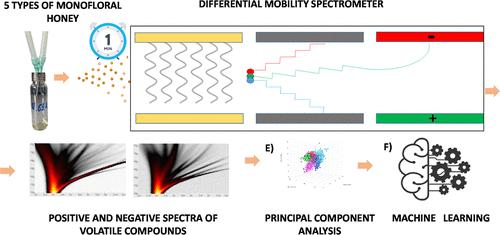差分迁移谱法鉴定五种单花蜂蜜的植物来源
IF 6.2
1区 农林科学
Q1 AGRICULTURE, MULTIDISCIPLINARY
引用次数: 0
摘要
差分迁移率光谱法(DMS)能够检测和分离挥发性有机化合物,利用不同电场下离子迁移率的差异,提高复杂混合物的分辨率。在本研究中,DMS与化学计量学相结合,使意大利蜂蜜的植物起源的区分成为可能。利用连接到纯空气的台式差分迁移谱仪,在正离子和负离子模式下同时分析了219种不同植物来源的单花蜂蜜(金合欢、栗子、柑橘、桉树和椴树),分析时间小于2分钟。通过余弦相似度验证了所得挥发物指纹图谱的重复性,随后消除了不可重复的数据。然后,将两个极性的数据串接起来,通过主成分分析对DMS的识别能力进行了探索性研究。然后将合并后的数据提交给统计分析进行分类。所得到的随机森林(RF)分类器的性能通过反复交叉验证和重新替换到训练集中进行评估,最后,该分类器在保留的数据子集上进行验证。通过计算列联表衍生参数的准确性、马修相关系数(MCC)、敏感性和特异性来评估每种测试的分类模型的性能。RF分类器在训练(MCC 84.8%,准确性88.0%,灵敏度87.5%,特异性96.9%)和验证子集(MCC 82.6%,准确性86.3%,灵敏度85.7%,特异性96.5%)中预测蜂蜜的植物来源时产生了高性能值。在对金合欢蜂蜜的正确分类中遇到了一些限制,预计将通过进一步的研究得到缓解。本文章由计算机程序翻译,如有差异,请以英文原文为准。

Differential Mobility Spectrometry Authenticates the Botanical Origins of Five Monofloral Honeys
Differential mobility spectrometry (DMS) enables the detection and separation of volatile organic compounds, exploiting differences in ion mobility under varying electric fields, which enhance the resolution of complex mixtures. In this study, DMS, upon integration with chemometrics, enabled the differentiation of the botanical origins of Italian honeys. Utilizing a benchtop differential mobility spectrometer connected to pure air, 219 monofloral honeys of five different botanical origins (acacia, chestnut, citrus, eucalyptus, and linden) were simultaneously analyzed in positive and negative ion modes and with the analysis duration of less than 2 min. Repeatability of the resultant volatilomic fingerprints was verified by cosine similarity with the subsequent elimination of the nonrepeatable data. Afterward, the data for both polarities were concatenated, and an exploratory investigation was carried out into the discrimination capabilities of DMS by principal component analysis. The merged data were then submitted to a statistical analysis for classification. The performance of the resultant random forest (RF) classifier was evaluated by repeated cross-validation and resubstitution into the training set, and finally, this classifier was validated on a withheld subset of data. The performances of the classification model for each test were evaluated by calculating the contingency table-derived parameters of accuracy, Matthew’s correlation coefficient (MCC), sensitivity, and specificity. The RF classifier produced high-performance values when predicting the botanical origin of the honey in both training (MCC 84.8%, accuracy 88.0%, sensitivity 87.5%, and specificity 96.9%) and validation subsets (MCC 82.6%, accuracy 86.3%, sensitivity 85.7%, and specificity 96.5%). Some limitations, expected to be mitigated by further research, were encountered in the correct classification of acacia honey.
求助全文
通过发布文献求助,成功后即可免费获取论文全文。
去求助
来源期刊
CiteScore
9.90
自引率
8.20%
发文量
1375
审稿时长
2.3 months
期刊介绍:
The Journal of Agricultural and Food Chemistry publishes high-quality, cutting edge original research representing complete studies and research advances dealing with the chemistry and biochemistry of agriculture and food. The Journal also encourages papers with chemistry and/or biochemistry as a major component combined with biological/sensory/nutritional/toxicological evaluation related to agriculture and/or food.

 求助内容:
求助内容: 应助结果提醒方式:
应助结果提醒方式:


